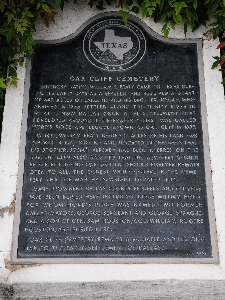Kentucky native William S. Beaty moved to the Texas Republic soon after the Battle of the Alamo and settled on a 640 acre tract of land fronting on the Trinity River. On July 16, 1844, Martha A. Wright, born May 24, 1844, was buried in what is now Oak Cliff Cemetery. This is the oldest marked grave in the cemetery. This daughter of John W. and Sarah Wright was probably the third child not of American Indian descent born in Dallas County. Some time soon thereafter, Josiah G. Beaty, brother of William S., was buried in the Cemetery, but his grave remains unmarked.
On June 5, 1846, William S. Beaty deeded “ten acres more or less” of his original 640 acres to be used for burial purposes for the new settlement west of the Trinity River. Mr. Beaty established the burial ground, “in consideration of the good will I bear the settlement…and also in order that the buried remains of my beloved brother may not be disturbed or the land in which he lies be ploughed.”
The “settlement” named in the Beaty Deed Trust grew slowly at first after Texas became a state in 1845 and Dallas County was created in 1846. William H. Hord arrived in January, 1845, and, as Hord’s Ridge, the settlement almost became the seat of Dallas County in 1850 (the village of Dallas won the election by a margin of only 28 votes). Hord was a county judge and married the first couple in the newly created Dallas County. Both he and his wife lie in Oak Cliff Cemetery.
Hord’s Ridge did not become Oak Cliff until 1887. By then the Cemetery was in general use, and many prominent Oak Cliff families were or would be buried there. Although most of Oak Cliff’s early landmarks have long since disappeared, the Oak Cliff Cemetery remains as a valuable and historic link with the pioneer days of Dallas County when a few hardy pioneers began homes in North Texas.
Today, the Cemetery is governed by a self-perpetuating Board of Trustees. Income from a trust fund established in 1955 provides maintenance income for the Cemetery’s general areas. Donations and bequests enable the Trustees to make improvements from time to time. Individual families are responsible for maintaining the grave sites of their loved ones.

